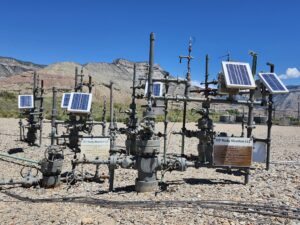Table of Contents Show
New rules would limit use of fresh water in oil-and-gas operations
To reduce the amount of fresh water used in oil-and-gas drilling, operators must ensure a certain percentage of water they are using in extraction is reused or recycled under a plan set to be released in the next week by a legislatively created advisory group.
The strategy from the Colorado Produced Water Consortium — a group of 31 energy, environmental and water experts that has been meeting for more than a year — will mark the first time Colorado has attempted to curb use of fresh water in the industry. Consortium members are required to produce a report with recommendations by Nov. 1, and the Colorado Energy and Carbon Management Commission is scheduled to hold a hearing in December to put new rules into place.
Oil-and-gas companies use less than 1% of the state’s consumed water, as compared to the 85% that is used by the agricultural sector. But unlike agriculture, most of what is used by oil and gas is not recycled but rather put into disposal wells, a fact that has become a particular concern to environmentalists during a time of drought.
The use of recycled water by energy companies varies wildly across the state, based significantly on the presence of infrastructure to transport the recycled water. In the Piceance Basin on the Western Slope, about 85% of water for oil-and-gas operations is recycled or reused, said Hope Dalton, director of the produced water consortium; in the Denver-Julesburg basin stretching south from Weld County, the total is just 2%.
Proposed limits on use of fresh water
The consortium will recommend that oil-and-gas development plans throughout the state include a minimum of 4% of water that is recycled or reused by 2026 and then a minimum of 10% by 2030. Dalton revealed this when she gave the ECMC a preview of the plan during its Oct. 16 meeting.
Colorado Produced Water Consortium Director Hope Dalton (lower right) discusses strategies with the Colorado Energy and Carbon Management Commission during an Oct. 16 virtual meeting.
Consortium members agreed that the minimum recycled-water usage should continue to rise to 20% by 2034 and 35% by 2038, but they also acknowledged that the technology doesn’t yet exist to make those goals reachable. As such, the group plans to continue studying potential legal changes that must be made in order for operators to take advantage of new technology when it comes online, she said.
“Everyone recognizes that conserving water helps the environment and saves money,” Dalton said. “The 4% is something we believe is achievable right now. The 10% is something we believe is achievable with increased infrastructure.”
How fresh water cuts can be achieved
The first move that could be made to cut fresh-water usage in wells is to take disposal wells that long have been used as dump sites for water brought up from the ground in drilling and turn them into storage wells that hold water to be used again in hydraulic fracturing. The technology needed for that conversion remains in development still, Dalton said, so the state must examine its regulations around these wells to ensure that when operators can pull water back out of them for reuse, no statutes stand in the way of that.
Once that is doable, companies could drill wells to store produced water on the same sites as the wells they’re drilling, and then they could truck the used water to fracking sites. Consortium members estimated that transporting the water to fracking sites within a five-mile radius of the storage wells could reduce the vehicle miles traveled by these trucks, which often now haul the water to disposal wells that are further away.

Natural gas wells near Parachute, Colorado
Not only could such a plan reduce vehicle-based emissions, but it could cut down use of fresh water at these sites significantly, Dalton said. For every 5% increase in the use of recycled or reused water, Colorado can save 1,296 acre-feet of water per year — the amount used by about 2,600 households annually.
While the advent of storage wells should be enough to reach the 10% goals, more investment will be needed achieve greater savings. That could include construction of pipe infrastructure to transport the reused water — piping that Dalton suggested could be built in conjunction with natural-gas pipelines from sites — and the addition of water-treatment plants and storage facilities.
Obstacles to achieving goals remain
ECMC member Mike Cross asked how greater cutbacks could be achieved, particularly given that the bill that established the consortium also banned construction of water-treatment plants and storage facilities in disproportionately impacted communities. Colorado defines a DIC as an area with a higher percentage of poor or minority residents or existing levels of raised emissions, and the Western Slope has much larger DICs than the Front Range because of the presence of lower-income rural residents, Cross noted.

Colorado Energy and Carbon Management Commission member Mike Cross addresses a virtual ECMC meeting.
“That is a topic that needs a lot more investigation,” acknowledged Dalton, adding that consortium members believe that the ECMC should re-examine both the goals and rules around recycled water usage every four years to ensure the plan is working.
Recommending statewide standards rather than establishing different requirements on a basin-by-basin basis will lead to greater simplification in regulations but also holds drawbacks. Most producers in the D-J Basin will have to boost the percentage of recycled water they are using, but Piceance Basin producers already exceed the new minimum levels exponentially, meaning they could backslide significantly and still be in compliance.
Ensuring continued conservation on Western Slope
To that end, Dalton suggested that the ECMC find ways in the rules it passes to reward producers with higher levels of reuse.
“The hope is that even if the commission adopts numbers lower than what’s happening in the Piceance, the operators will continue to recycle at high levels,” she said.
The initially proposed minimum recycling levels are far lower than those originally set out in House Bill 23-1242, which sought to cut freshwater usage 75% by 2026 and 90% by 2030. But oil-and-gas leaders criticized such drastic cuts at the time as being unrealistic, and the bill was reworked to create the consortium so that state officials could get informed input from experts in the field in order to craft achievable cutbacks.
Dalton, in giving the ECMC a preview of the recommendations, emphasized that she believes the group “avoided overregulating or underregulating.” The new regulations come as the ECMC just passed the first rules to minimize the cumulative impacts of industrial and energy operations on certain communities and is about to set new rules to reduce emissions from the midstream sector of the industry.
Seeking a balance in reducing fresh water usage
Overarching concerns remain. The consortium wants to avoid any changes that would boost air emissions, even if the concurrently reduce the use of fresh water. Thus, it wants to stay focused on solutions that don’t increase truck traffic before there is underground infrastructure in place to transport reused water, Dalton said.
But ECMC members were laudatory of the outlined strategy, with member Trisha Oeth saying she found it “pretty remarkable” that the consortium achieved consensus among its members of various interests. And thus, the state looks poised before the end of 2024 to put into place rules that represent a first step toward a broadly accepted goal.
“Looking forward, the Produced Water Consortium really wants to focus on reducing fresh water use in oil and gas activities,” Dalton said.





/cloudfront-us-east-1.images.arcpublishing.com/morningstar/4GFHCBJWTRADHCPVASW6HQCQXI.png?w=332&resize=332,0&ssl=1)
/cloudfront-us-east-1.images.arcpublishing.com/morningstar/4GFHCBJWTRADHCPVASW6HQCQXI.png?w=664&resize=664,372&ssl=1)







